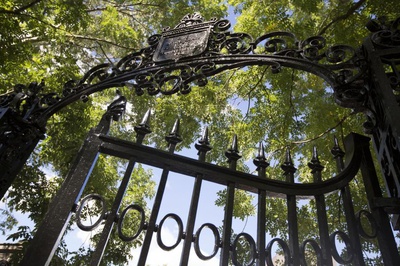
News
Harvard Grad Union Agrees To Bargain Without Ground Rules

News
Harvard Chabad Petitions to Change City Zoning Laws

News
Kestenbaum Files Opposition to Harvard’s Request for Documents

News
Harvard Agrees to a 1-Year $6 Million PILOT Agreement With the City of Cambridge

News
HUA Election Will Feature No Referenda or Survey Questions
The Sarcophagus of Alexander the Great.
Some time ago in the course of excavations at Sidon, eleven sarcophagi were discovered; four Phoenician and seven Greek. The Greek ones have been removed to Constantinople and will be exhibited as soon as a fitting room can be prepared. One of these is of such immense proportions and so magnificent that it was thought to be the tomb of some Assyrian king. Investigations were made and finally the conclusion was reached that it was the sarcophagus of Alexander the Great. Its sculpture, on this theory, represents the battle of Arbela, a lion hunt and the battle of Granicus. The sarcophagus is nearly twelve feet long, seven high and five and a half broad, and the total weight is twenty-five tons, of which the cover weighs ten. It is all of fine Parian marble. Several French savants are now studying it at Constantinople.
Want to keep up with breaking news? Subscribe to our email newsletter.
Most Read
- Harvard Dismisses Leaders of Center for Middle Eastern Studies
- More Than 80 HLS Professors Denounce Trump Admin Attacks on Law Firms in Letter to Students
- 2 Years After Affirmative Action Ruling, Harvard Admits Class of 2029 Without Releasing Data
- FAS Dean Asks Center Directors To Show Compliance With Viewpoint Diversity Guidance
- Harvard Agrees to a 1-Year $6 Million PILOT Agreement With the City of Cambridge
From Our Advertisers

Over 300+ courses at prestigious colleges and universities in the US and UK are at your disposal.

With innovative financial tools combined with financial education, Collegiate empowers students to take control of their finances and build confidence in their money management skills.

Serve as a proctor for Harvard Summer School (HSS) students, either in the Secondary School Program (SSP), General Program (GP), or Pre-College Program.

With an increasingly competitive Law School admissions process, it's important to understand what makes an applicant stand out.

Welcome to your one-stop gifting destination for men and women—it's like your neighborhood holiday shop, but way cooler.

Admit Expert is a premium MBA admissions consulting company, helping candidates secure admission to top B-schools across the globe with significant scholarships.
